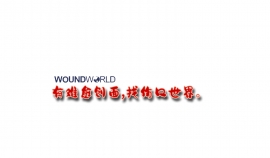
伤口世界

- 星期一, 15 5月 2023
Intra-wound versus systemic vancomycin for preventing surgical site infection induced by methicillin-resistant S. aureus after spinal implant surgery in a rat model
Jian Wei1*† iD, Hanwen Gu2† and Kai Tong2
† Jian Wei and Hanwen Gu have contributed equally to this work
*Correspondence:
Jian Wei
该Email地址已收到反垃圾邮件插件保护。要显示它您需要在浏览器中启用JavaScript。
1 Department of Orthopedic Surgery, Liuzhou People’s Hospital Affiliated to Guangxi Medical University, Liuzhou 545006, China
2 Department of Orthopedic Surgery, Zhongnan Hospital of Wuhan University, Wuhan 430071, China
Abstract
Background Systemic vancomycin administration pre-operatively for the infection prophylaxis of spinal implant surgery remains unsatisfactory. This study aimed to explore the efcacy and dosage of local use of vancomycin powder (VP) in preventing surgical site infections after spinal implant surgery in a rat model.
Methods Systemic vancomycin (SV; intraperitoneal injection, 88 mg/kg) or intraoperative intra-wound VP (VP0.5: 44 mg/kg, VP1.0: 88 mg/kg, VP2.0: 176 mg/kg) was applied after spinal implant surgery and methicillin-resistant S. aureus (MRSA; ATCC BAA-1026) inoculation in rats. General status, blood inflammatory biomarkers, microbiological and histopathological evaluation were performed during 2 weeks post-surgery.
Results No post-surgical deaths, wound complications and obvious signs of vancomycin adverse effects were observed. Bacterial counts, blood and tissue inflammation were reduced in the VP groups compared with the SV group. VP2.0 group showed better outcomes in weight gain and tissue inflammation than the VP0.5 and VP1.0 group. Microbial counts indicated that no bacteria survived in the VP2.0 group, whereas MRSA was detected in VP0.5 and VP1.0 groups.
Conclusions Intra-wound VP may be more effective than systemic administration in preventing infection caused by MRSA (ATCC BAA-1026) after spinal implant surgery in a rat model.
Keywords Postoperative infection, Spinal implant surgery, Intra-wound vancomycin powder, Infection prophylaxis, Rat model
© The Author(s) 2023. Open Access This article is licensed under a Creative Commons Attribution 4.0 International License, which permits use, sharing, adaptation, distribution and reproduction in any medium or format, as long as you give appropriate credit to the original author(s) and the source, provide a link to the Creative Commons licence, and indicate if changes were made. The images or other third party material in this article are included in the article’s Creative Commons licence, unless indicated otherwise in a credit line to the material. If material is not included in the article’s Creative Commons licence and your intended use is not permitted by statutory regulation or exceeds the permitted use, you will need to obtain permission directly from the copyright holder. To view a copy of this licence, visit http://creativecommons.org/licenses/by/4.0/. The Creative Commons Public Domain Dedication waiver (http://creativecommons.org/publicdomain/zero/1.0/) applies to the data made available in this article, unless otherwise stated in a credit line to the data.

- 星期四, 11 5月 2023
Evaluation of the therapeutic efect of dressing containing Silver (Ag coat) in the process of healing skin blisters caused by limb fractures: a clinical trial study
Mehdi Teimouri1 and Sahar sadat Lalehzar2*
Abstract
Background The main activity of the skin is to create a protective barrier against damage. Loss of the skin due to injury or disease and failure to regenerate the affected area may result in disability, infection, or even death. We conducted a clinical trial to evaluate the therapeutic effect of dressing containing silver in process of healing skin blisters caused by limb fractures.
Method This is a pioneering randomized trial that compares the effectiveness of two dressings containing silver (Ag coat) and Gaz Vaseline among patients with skin blisters due to bone fractures who were randomly selected from patients referred to the Kashani Medical Training Center. There were two treatment groups containing 16 patients treated with Ag coat and 15 patients treated with Gaz Vaseline. Pictures were taken of blisters on days 0, 7, and 14 to evaluate the healing process. The amount of pain, duration of the visit (measured by minutes), and general condition of the wound were checked. The amount of pain, duration of visit (measured by minutes) and general condition of the wound was checked. All continuous and categorical data are presented as mean±standard deviation (SD) and frequency (percentage), respectively. Paired sample T-test and repeated measure analysis of variance (ANOVA), Chisquared test was used. All pictures were analyzed by Mosaic soft ward.
Result During this study, there was no significant difference between the mean of age and BMI and frequency of gender in the two study groups (P>0.05). There was a significant difference in mean between the duration of the visit, number of dressings, and net cost of dressing (p < 0.05). In the macroscopic study and analysis for evaluation and comparing wound area with the Mosaic soft ward, there was significant relation in time (p1=0.00). There is no significant difference between the groups (p2=0.84). There was a significant difference between time and group (p3 =0.00). On day 14 the wound area between groups had a significant difference (p4 =0.00) (Table 3). In the VAS score there was a significant difference in time, and group (p1,2 =0.00), there was no significant relation between time and group (p3=0.62). On all days the wound area between groups had a significant difference (p4=0.00).
Conclusion In conclusion, Ag coat dressing, not only has a significant effect on wound healing but also, decreases pain, shorter visit time, and its more cost-effective.
Keywords Blister, Bone fracture, Lower extremity, Silver
*Correspondence:
Sahar sadat Lalehzar
该Email地址已收到反垃圾邮件插件保护。要显示它您需要在浏览器中启用JavaScript。
Full list of author information is available at the end of the article
© The Author(s) 2023. Open Access This article is licensed under a Creative Commons Attribution 4.0 International License, which permits use, sharing, adaptation, distribution and reproduction in any medium or format, as long as you give appropriate credit to the original author(s) and the source, provide a link to the Creative Commons licence, and indicate if changes were made. The images or other third party material in this article are included in the article’s Creative Commons licence, unless indicated otherwise in a credit line to the material. If material is not included in the article’s Creative Commons licence and your intended use is not permitted by statutory regulation or exceeds the permitted use, you will need to obtain permission directly from the copyright holder. To view a copy of this licence, visit http://creativecommons.org/licenses/by/4.0/. The Creative Commons Public Domain Dedication waiver (http://creativeco mmons.org/publicdomain/zero/1.0/) applies to the data made available in this article, unless otherwise stated in a credit line to the data.

- 星期三, 10 5月 2023
Core decompression with β-tri-calcium phosphate grafts in combination with platelet-rich plasma for the treatment of avascular necrosis of femoral head
Jinyang Lyu1,2†, Tiancong Ma1,2†, Xin Huang1,2, Jingsheng Shi1 , Gangyong Huang1,3, Feiyan Chen1 , Yibing Wei1 ,Siqun Wang1 , Jun Xia1 , Guanglei Zhao1*† and Jie Chen1*†
† Jinyang Lyu and Tiancong Ma contributed equally to this work and share first
† Guanglei Zhao and Jie Chen contributed equally to this work and should be regarded as co-corresponding authors.
*Correspondence:
Guanglei Zhao
该Email地址已收到反垃圾邮件插件保护。要显示它您需要在浏览器中启用JavaScript。
Jie Chen
该Email地址已收到反垃圾邮件插件保护。要显示它您需要在浏览器中启用JavaScript。
Full list of author information is available at the end of the article
Abstract
Background This study was aimed to investigate whether the application of platelet-rich plasma (PRP) combined with β-tri-calcium phosphate (β-TCP) grafts after core decompression (CD) could improve the clinical outcomes of early stage of avascular necrosis of femoral head.
Methods Forty-five (54 hips) patients with Ficat-Arlet classification stage |-II treated by CD with β-TCP grafts with or without the application of PRP from July 2015 to October 2020 were reviewed. Group A (CD+ β-TCP grafts) included 24 patients (29 hips), while group B (CD + β-TCP grafts + PRP) included 21 patients (25 hips). Visual analogue scale (VAS) score, Harris hip score (HHS), change in modified Kerboul angle and the hip joint survival were evaluated and compared between the groups. Patients had a mean follow-up period of 62.1士17.2 months and 59.3土14.8 months in group A and group B, respectively.
Results The mean VAS scores in group A was significantly higher than group B at the 6 months (2.9士0.7vs 1.9士0.6, p< 0.01) and final follow up postoperative (2.8士1.2 VS 2.2士0.7, p= 0.04). The mean HHS in group A was significantly lower than group B at the 6 months (80.5土13.8 VS 89.8士12.8, p= 0.02). However, at the final follow up, there is no
significant difference between the groups (77.0土12.4 VS 83.1土9.3, p=0.07). The mean change in modified Kerboul angle was -7.4士10.6 in group A and -19.9士13.9 in group B which is statistically significant (P <0.01). Survivorship from total hip arthroplasty were 86.2%/84% (p = 0.86) at the final follow up, which was not statistically significant. No serious complications were found in both groups.
Conclusions A single dose of PRP combined with CD and β-TCP grafts provided significant pain relief, better functional outcomes, and delayed progression in the short term compared to CD combined with β-TCP grafts. However, the prognosis of the femoral head did not improve significantly in the long term. In the future, designing new implants to achieve multiple PRP injections may improve the hip preservation rate.
Keywords Core decompression, Platelet-rich plasma, Avascular necrosis of femoral head, Hip-preserving strategy, β-tri-calcium phosphate
© The Author(s) 2023. Open Access This article is licensed under a Creative Commons Attribution 4.0 International License, which permits use, sharing, adaptation, distribution and reproduction in any medium or format, as long as you give appropriate credit to the original author(s) and the source, provide a link to the Creative Commons licence, and indicate if changes were made. The images or other third party material in this article are included in the article’s Creative Commons licence, unless indicated otherwise in a credit line to the material. If material is not included in the article’s Creative Commons licence and your intended use is not permitted by statutory regulation or exceeds the permitted use, you will need to obtain permission directly from the copyright holder. To view a copy of this licence, visit http://creativecommons.org/licenses/by/4.0/. The Creative Commons Public Domain Dedication waiver (http://creativeco mmons.org/publicdomain/zero/1.0/) applies to the data made available in this article, unless otherwise stated in a credit line to the data.

- 星期一, 08 5月 2023
Keloid treatments: an evidence-based systematic review of recent advances
Laura A. Walsh1,2, Ellen Wu1 , David Pontes1 , Kevin R. Kwan1 , Sneha Poondru2 , Corinne H. Miller1 and Roopal V. Kundu1,2*
*Correspondence:
Roopal V. Kundu 该Email地址已收到反垃圾邮件插件保护。要显示它您需要在浏览器中启用JavaScript。
1 Northwestern University Feinberg School of Medicine, Chicago, IL, USA
2 Department of Dermatology, Northwestern University Feinberg School of Medicine, Chicago, IL 60611, USA
Abstract
Background Keloids are pathologic scars that pose a significant functional and cosmetic burden. They are challenging to treat, despite the multitude of treatment modalities currently available.
Objective The aim of this study was to conduct an evidence-based review of all prospective data regarding keloid treatments published between 2010 and 2020.
Methods A systematic literature search of PubMed (National Library of Medicine), Embase (Elsevier), and Cochrane Library (Wiley) was performed in November of 2020. Search strategies with the keywords “keloid” and “treatment” were performed by a medical librarian. The search was limited to prospective studies that were peer-reviewed, reported on clinical outcomes of keloid therapies, and were published in the English language between January 1, 2010, and November 24, 2020.
Results A total of 3462 unique citations were identified, of which 108 studies met inclusion criteria. Current literature supports silicone gel or sheeting with corticosteroid injections as first-line therapy for keloids. Adjuvant intralesional 5-fuorouracil (5-FU), bleomycin, or verapamil can be considered, although mixed results have been reported with each. Laser therapy can be used in combination with intralesional corticosteroids or topical steroids with occlusion to improve drug penetration. Excision of keloids with immediate post-excision radiation therapy is an effective option for recalcitrant lesions. Finally, silicone sheeting and pressure therapy have evidence for reducing keloid recurrence.
Conclusions This review was limited by heterogeneity of subject characteristics and study outcome measures, small sample sizes, and inconsistent study designs. Larger and more robust controlled studies are necessary to further understand the variety of existing and emerging keloid treatments, including corticosteroids, cryotherapy, intralesional injections, lasers, photodynamic therapy, excision and radiation, pressure dressings, and others.

- 星期六, 06 5月 2023
Severe skin and soft tissue infection in the left upper limb caused by Aeromonas veronii: a case report
Linhui Li1†, Jie Huang1†, Long Xu1 , Guangyi Wang1 , Shichu Xiao1 , Zhaofan Xia1 , Qin Qin2 , Yazhou Li2 and Shizhao Ji1* iD
† Linhui Li and Jie Huang contributed equally to this work.
*Correspondence:
Shizhao Ji
该Email地址已收到反垃圾邮件插件保护。要显示它您需要在浏览器中启用JavaScript。
1 Department of Burns, Burn Institute of PLA, The First Affiliated Hospital of Naval Medical University, No. 168 Changhai Road, Yangpu District, Shanghai 200433, China
2 Department of Laboratory Diagnosis, The First Affiliated Hospital of Naval Medical University, No. 168 Changhai Road, Yangpu District,
Shanghai 200433, China
Abstract
Introduction Skin and soft tissue infections are common because of exposure to aquatic environment, while severe infections caused by Aeromonas veronii are rare.
Case presentation We report a case of severe skin and soft tissue infection of the left upper limb caused by Aeromonas veronii. A 50-year-old Chinese woman, who had a history of cardiac disease and type 2 diabetes mellitus, accidentally injured her left thumb while cutting a fish. Early antibiotic therapy and surgical debridement was performed before the result of bacterial culture came back. Whole-genome sequencing was further performed to confirm the pathogen and reveal the drug resistance and virulence genes. The wound was gradually repaired after 1 month of treatment, and the left hand recovered well in appearance and function after 3 months of rehabilitation.
Conclusion Early diagnosis, surgical intervention, and administration of appropriate antibiotics are crucial for patients who are suspected of having skin and soft tissue infection, or septicemia caused by Aeromonas veronii.
Keywords Aeromonas veronii, Wound infection, Antibiotic therapy, Whole-genome sequencing, Case report

- 星期四, 04 5月 2023
Role of vitamin D and calcium signaling in epidermal wound healing
D. Bikle1
Received: 19 April 2022 / Accepted: 31 July 2022 / Published online: 13 August 2022
© The Author(s), under exclusive licence to Italian Society of Endocrinology (SIE) 2022
D. D. Bikle
该Email地址已收到反垃圾邮件插件保护。要显示它您需要在浏览器中启用JavaScript。
1 Department of Medicine and Dermatology, University of California San Francisco, San Francisco VA Medical Center, San Francisco, USA
Abstract
Purpose This review will discuss the role of vitamin D and calcium signaling in the epidermal wound response with particular focus on the stem cells of the epidermis and hair follicle that contribute to the wounding response.
Methods Selected publications relevant to the mechanisms of wound healing in general and the roles of calcium and vitamin D in wound healing in particular were reviewed.
Results Following wounding the stem cells of the hair follicle and interfollicular epidermis are activated to proliferate and migrate to the wound where they take on an epidermal fate to re-epithelialize the wound and regenerate the epidermis. The vitamin D and calcium sensing receptors (VDR and CaSR, respectively) are expressed in the stem cells of the hair follicle and epidermis where they play a critical role in enabling the stem cells to respond to wounding. Deletion of Vdr and/or Casr from these cells delays wound healing. The VDR is regulated by co-regulators such as the Med 1 complex and other transcription factors such as Ctnnb (beta-catenin) and p63. The formation of the Cdh1/Ctnn (E-cadherin/catenin) complex jointly stimulated by vitamin D and calcium plays a critical role in the activation, migration, and re-epithelialization processes.
Conclusion Vitamin D and calcium signaling are critical for the ability of epidermal and hair follicle stem cells to respond to wounding. Vitamin D deficiency with the accompanying decrease in calcium signaling can result in delayed and/or chronic wounds, a major cause of morbidity, loss of productivity, and medical expense.
Keywords Vitamin D · Calcium · Keratinocytes · Wounding · p63 · Stem cells
